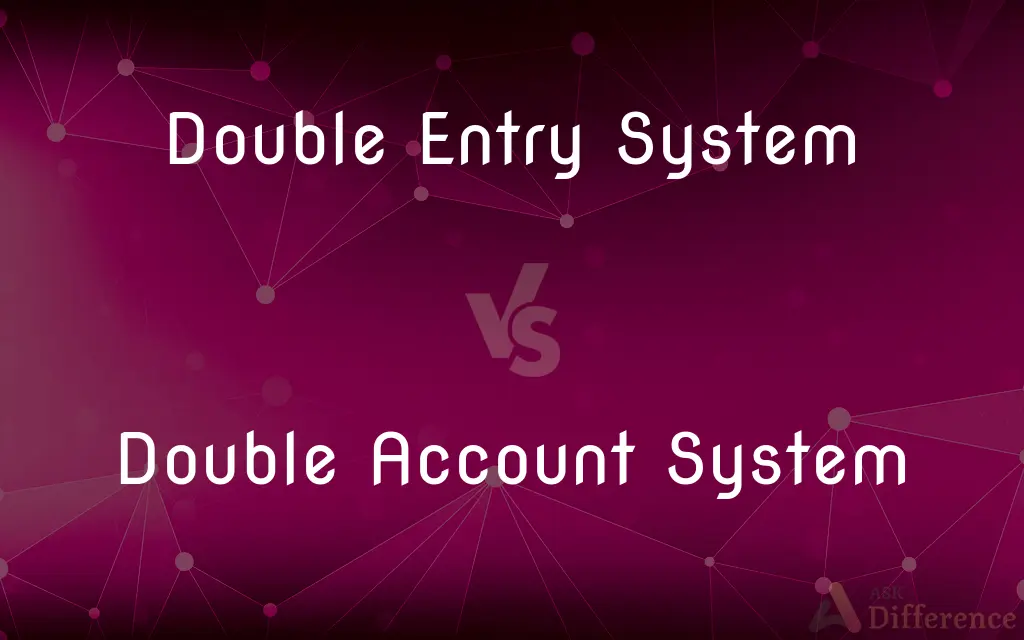Double Entry System vs. Double Account System — What's the Difference?
By Tayyaba Rehman — Published on January 10, 2024
Double Entry System is an accounting method recording each transaction twice, while Double Account System is used mainly by public utilities for separate capital and revenue transactions.

Difference Between Double Entry System and Double Account System
Table of Contents
ADVERTISEMENT
Key Differences
The Double Entry System in accounting is a method where every transaction is recorded in at least two accounts, involving a debit in one account and a corresponding credit in another. This system ensures the accounting equation (Assets = Liabilities + Equity) always remains balanced. The Double Account System, on the other hand, is a specialized accounting system, primarily used by joint-stock companies, especially in the public utilities sector. It involves maintaining two distinct sets of accounts: one for capital expenditures and the other for routine operational expenses and revenue.
Double Entry System is a fundamental concept in modern accounting, used universally across various types of businesses. It provides a comprehensive view of a company's financial transactions, ensuring accuracy and helping to prevent errors and fraud. In contrast, the Double Account System is more specific in its application, often utilized in industries like railways, electricity, and water companies, where there is a clear distinction between capital and revenue expenditures.
The main advantage of the Double Entry System is its ability to provide a complete and balanced financial picture of a business, making it easier to detect errors and omissions. The Double Account System is beneficial for companies that need to clearly segregate capital investment and operational costs, often due to regulatory requirements or specific industry practices.
In terms of financial reporting, the Double Entry System leads to the creation of essential financial statements like the balance sheet, income statement, and cash flow statement. The Double Account System, however, results in two sets of accounts – one showing the capital and assets and the other showing revenue and expenses, providing a clear distinction between long-term investment and daily operational finances.
The implementation of the Double Entry System requires understanding of basic accounting principles and can be applied to businesses of all sizes. The Double Account System requires a more specialized approach, understanding the unique financial structure of companies in sectors like utilities or infrastructure.
ADVERTISEMENT
Comparison Chart
Basic Concept
Records each transaction twice (debit and credit)
Maintains separate accounts for capital and revenue
Usage
Universal in all types of businesses
Used mainly by public utilities and joint-stock companies
Financial Reporting
Creates balance sheet, income statement, etc.
Produces two sets of accounts for different transaction types
Purpose
Ensures accuracy, prevents fraud
Segregates capital investment from operational costs
Industry Application
Applicable to all industries
Primarily in industries like railways, electricity, and water
Compare with Definitions
Double Entry System
Balances the accounting equation: Assets = Liabilities + Equity.
In the double entry system, issuing stock results in a debit to cash and a credit to equity.
Double Account System
Commonly used in public utility companies.
In the double account system, a railway company separately reports investments in tracks and trains and daily ticket revenues.
Double Entry System
Universal accounting method for accuracy and completeness.
Each sale is recorded as a debit to accounts receivable and a credit to sales revenue in the double entry system.
Double Account System
Provides clarity in financial reporting for specific industries.
The double account system helps electricity providers clearly report long-term investments and regular billing income.
Double Entry System
Fundamental in modern accounting practices.
The double entry system is taught as a basic accounting principle in business courses.
Double Account System
Segregates long-term investments from daily operational finances.
The double account system allows a public transportation company to separately track capital improvements and farebox revenues.
Double Entry System
Records financial transactions in two accounts, as debits and credits.
Purchasing office supplies is recorded as a debit in the supplies account and a credit in the cash account in the double entry system.
Double Account System
Maintains separate accounts for capital and revenue transactions.
A utility company uses the double account system to distinguish between capital expenditure for infrastructure and operational expenses.
Double Entry System
Helps in creating comprehensive financial statements.
The double entry system ensures the accuracy of a company's balance sheet and income statement.
Double Account System
Useful for regulatory and industry-specific financial practices.
Water supply companies use the double account system to meet regulatory reporting requirements.
Common Curiosities
What is the double account system?
It's an accounting system used mainly by public utilities to separate capital and revenue transactions.
Can small businesses use the double entry system?
Yes, businesses of all sizes can use the double entry system.
How does the double entry system prevent fraud?
By requiring each transaction to be recorded in two places, it provides a cross-check that helps detect errors and fraud.
What is the double entry system?
It's an accounting method where each transaction is recorded as both a debit in one account and a credit in another.
In what industries is the double account system typically used?
It's mainly used in industries like railways, electricity, and water supply.
Why do public utilities use the double account system?
To clearly separate long-term capital investments from day-to-day operational expenses.
Do companies need special software to implement these systems?
Modern accounting software typically supports both systems, facilitating their implementation and management.
Is the double entry system mandatory for all businesses?
While not legally mandatory everywhere, it is a widely accepted and standard accounting practice.
What types of transactions are recorded in the double account system?
Transactions related to capital expenditures and operational expenses are recorded separately.
How does the double entry system ensure accuracy in financial reporting?
The requirement to record each transaction twice helps ensure the balance sheet and income statement are accurate.
Does the double account system provide more detail than the double entry system?
It provides more detail in segregating different types of transactions, particularly useful in specific industries.
Who benefits from the double account system?
Stakeholders in industries like utilities benefit from the clear distinction between capital and operational financial activities.
Are the double entry system and the double account system compatible?
They serve different purposes but can be used complementarily in certain industries like utilities.
Is the double entry system easy to implement?
It requires a basic understanding of accounting principles but is generally straightforward.
What is the primary benefit of the double entry system?
Its primary benefit is providing a complete and balanced view of a company's financial transactions.
Share Your Discovery

Previous Comparison
Infrared Radiation vs. Ultraviolet Radiation
Next Comparison
T3 vs. T4Author Spotlight
Written by
Tayyaba RehmanTayyaba Rehman is a distinguished writer, currently serving as a primary contributor to askdifference.com. As a researcher in semantics and etymology, Tayyaba's passion for the complexity of languages and their distinctions has found a perfect home on the platform. Tayyaba delves into the intricacies of language, distinguishing between commonly confused words and phrases, thereby providing clarity for readers worldwide.













































